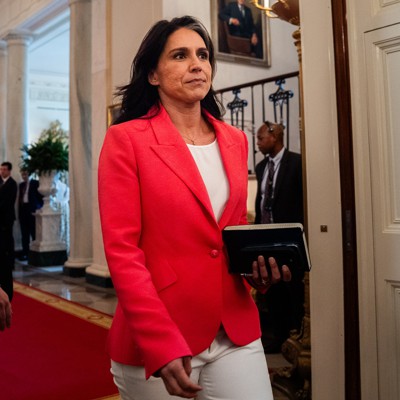The Office of the Director of National Intelligence, which has already shrunk its workforce by about one-quarter this year, will lose another 200 workers in coming weeks under an “ODNI 2.0” restructuring, the U.S. spy chief said Wednesday.
The office had slightly less than 2,000 employees at the start of the Trump administration and now has around 1,500. The additional cut would bring the year’s total reduction to about 35 percent.
In a press release, Director of National Intelligence Tulsi Gabbard said the changes would “reduce ODNI by over 40%” by Sept. 30 and “save taxpayers over $700 million per year.”
Gabbard said ODNI, which was established after the September 11 attacks to lead the U.S. intelligence community, has “become bloated and inefficient, and the intelligence community is rife with abuse of power, unauthorized leaks of classified intelligence, and politicized weaponization of intelligence.”
She also released a ODNI 2.0 “fact sheet” that laid out plans to eliminate or consolidate programs and components that have been deemed to be redundant or overly partisan. The plan includes “refocusing functions within the Foreign Malign Influence Center, the National Counterproliferation and Biosecurity Center, and the Cyber Threat Intelligence Integration Center, and integrating core functions and expertise from those offices into ODNI’s Mission Integration (MI) and the National Intelligence Council (NIC).”
The sheet said the External Research Council and its Strategic Futures Group will be shuttered because they “operated as hubs for injecting partisan priorities into intelligence products.”
Even before Gabbard announced the 2.0 plan, some top GOP lawmakers had already pushed to slim ODNI’s operations.
Sen. Tom Cotton, R-Ark., who chairs the Senate Intelligence Committee, introduced legislation in June to cap the office’s full-time workforce at 650 and restructure or terminate some of its internal entities.
In a statement on Wednesday, Cotton said the ODNI 2.0 restructuring will make the agency “a stronger and more effective national security tool for President Trump.”
Gabbard has moved to crack down on dissent across the IC, including announcing on Tuesday that she was revoking the security clearances of 37 current and former U.S. officials, saying without evidence that they had politicized their roles.
In May, she fired two top officials on the National Intelligence Council in May after the intelligence body composed an assessment that contradicted Trump’s claims that Venezuelan president Nicolás Maduro was overseeing the activities of a violent gang operating in the United States.
Last month, Gabbard issued a report that she said showed a contradiction between the IC’s internal assessments and public statements about Russian interference. But in fact, the public statement matched the internal assessments.
President Donald Trump and his Republican allies have long criticized the U.S. intelligence community, particularly after it concluded that Russia interfered in the 2016 presidential election on behalf of Trump. During his first term, he famously sided with Russia’s Vladimir Putin against the IC at their 2018 meeting in Helsinki. He and allies have called the IC part of a “deep state” of entrenched bureaucrats working to undermine the administration’s priorities.
Nextgov’s Edward Graham contributed to this report.
Read the full article here








Leave a Reply